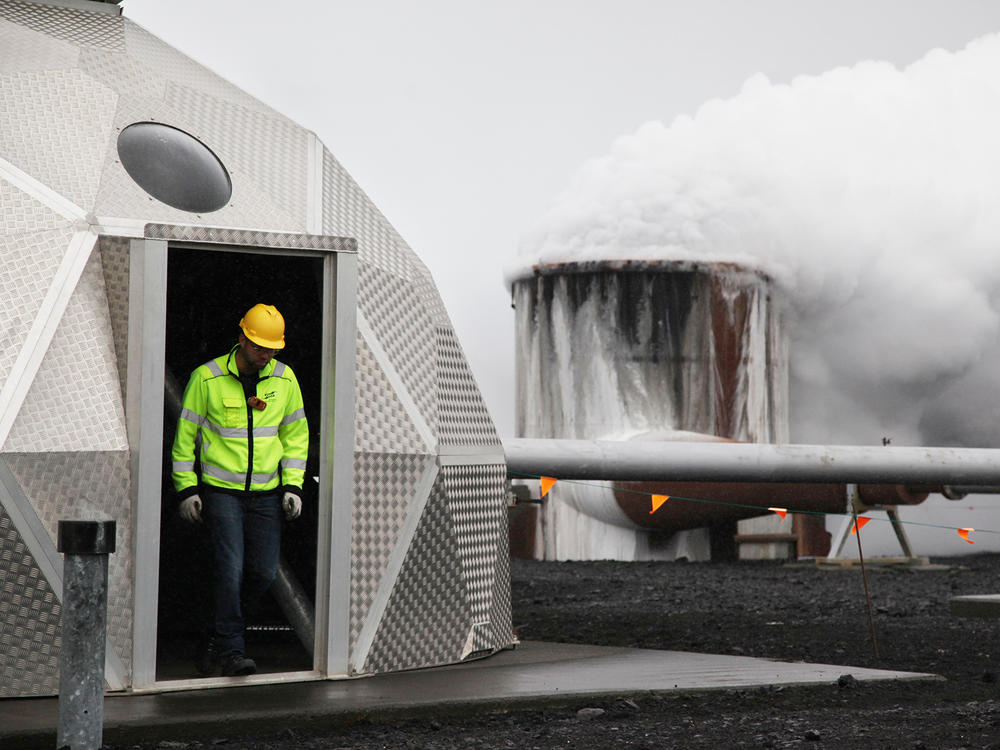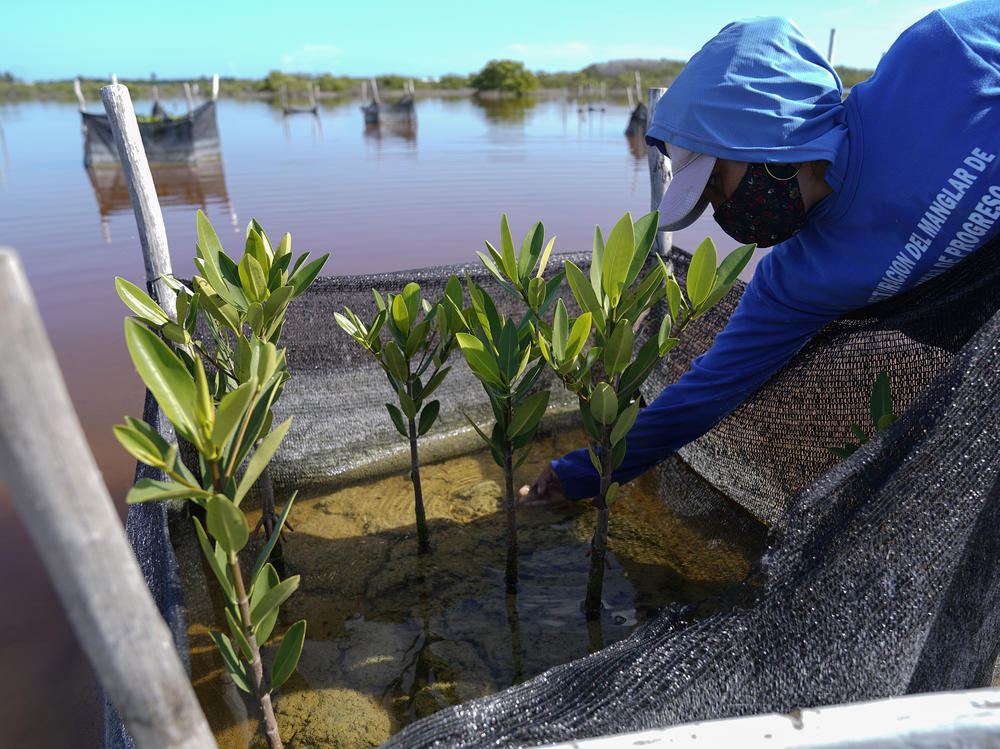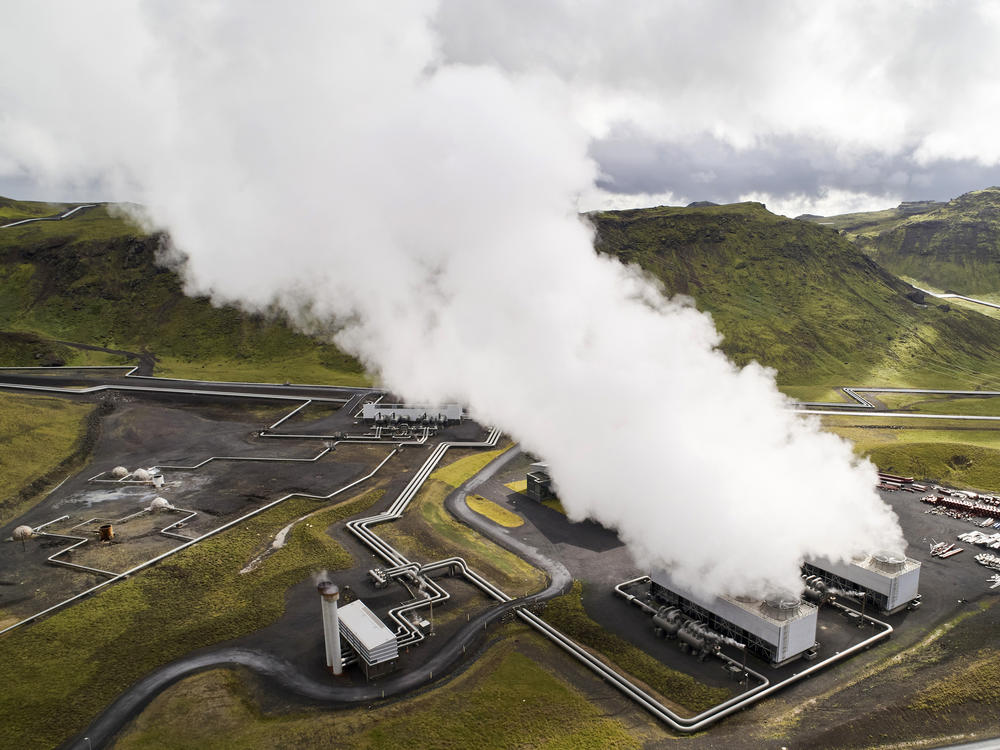Loading...
Section Branding
Header Content
Vacuuming carbon from the air could stop climate change. Not everyone likes the idea
Primary Content
Some of the biggest companies in the world, including Facebook and Google, are planning to spend almost $1 billion on a new climate change strategy.
It's not renewable energy or planting trees. It's pulling carbon dioxide emissions right out of the air.
The world has moved so slowly over the last 40 years to rein in greenhouse gases that scientists are now finding that cutting the use of fossil fuels alone may not be enough to stave off the worst effects of climate change. The world is on track for increasingly destructive heat waves, floods and storms. That means heat-trapping gases may also need to be pulled out of the atmosphere.
It's known as "carbon dioxide removal." In the latest international climate assessment, scientists found that using it will be "unavoidable" if countries are going to meet their pledges to keep average global temperatures from rising to ever-harmful levels.
Much of the technology to soak up carbon is still in its infancy. Some techniques can have significant impacts on the land. Some climate activists argue it's a risky distraction and that it would give the fossil fuel industry a free pass to keep operating.
Still, scientists running the numbers say the world has reached a point where every possible strategy is needed. Global emissions are still going the wrong direction. In 2021, they reached the highest level ever.
Why scientists say carbon removal is needed
To stave off extreme climate change impacts that could displace millions of people, scientific data show that greenhouse gas emissions need to fall fast. Emissions need to drop 43% by 2030 and then fall to net-zero by mid-century, in order to limit warming to 1.5 degrees Celsius (2.7 degrees Fahrenheit).
Some solutions to cut emissions, like using renewable energy, are already widespread and cost-effective. But some emissions will be trickier to tackle. Farming produces emissions both from disturbing the soil and from the use of fertilizers, which provide food for soil microbes that release heat-trapping gases. The technology to create aircraft and ocean-going shipping vessels that don't produce emissions is still experimental. Some industrial processes, like steel-making, require fuels that create extremely high heat.
By mid-century, those sectors may still be producing emissions. But by then, the overall level of greenhouse gases in the atmosphere needs to stop rising, much like keeping a bathtub from overflowing.
"If you want to stop the water level from going up, you either need to turn off the faucet or scoop out as much water as you put in," says Katherine Calvin, NASA's Chief Scientist and Senior Climate Advisor and an author on the IPCC report. "The same is true of climate. If you want to stop temperature from rising, you either need to stop carbon dioxide from going into the system or scoop out as much as you put in."
In essence, carbon dioxide removal is like scooping water out of the bathtub. It makes up for the emissions that still could be going into the atmosphere and potentially even more than that, removing emissions that have already been produced.
How does carbon removal work?
Simply put, the idea is to absorb carbon dioxide emissions that have already accumulated in the atmosphere. Then, those emissions would be locked away in some kind of permanent storage, generally in underground geologic formations, so they don't escape to create more warming down the road. But despite carbon dioxide's power to heat the planet, it's very diffuse, making up less than 1% of the atmosphere. That makes it tricky to capture from the air in large quantities.
Option 1: Use nature to absorb carbon emissions
Nature is the most powerful carbon sponge around us. Plants take up carbon dioxide through the process of photosynthesis, locking it away in their tissues, making the world's forests, grasslands, soils, and wetlands huge reservoirs of carbon. Building up these natural reserves could help slow warming, whether through planting forests, restoring wetlands and mangroves or encouraging agricultural practices that store carbon in the soil. This method is by far the cheapest so far. However, those ecosystems must be protected from development. If the plants and ecosystem are lost, the carbon escapes back into the atmosphere.
Option 2: Use leftover plants to make energy and capture the emissions
Plants are already used to make electricity in biomass power plants, which means while that plant material trapped carbon, the carbon is released in the process of generating energy. A handful of biomass power plants are working on capturing those carbon emissions and then storing them in underground geologic formations. It's known as "bioenergy with carbon capture and storage."
The biomass used is often leftover material, like waste from agricultural crops, forest harvests or food waste, or it can come from crops grown specifically for that purpose. This strategy has the added benefit of producing electricity at the same time. But scaling it up could require more land, putting pressure on wild ecosystems which also store carbon and provide habitat for wildlife. It would take an estimated 115,000 to 166,000 square miles of land, as large as California, to grow the biomass needed to pull 1 billion tons of carbon dioxide out of the air.
Option 3: Pull it out of the air with big machines
Last year, the largest carbon removal project of its kind started up in Iceland. The Orca plant, run by the Swiss company Climeworks, is essentially a carbon vacuum. Fans pull in air, the carbon is captured by a special material and then it's pumped underground into geologic formations where it mineralizes, remaining trapped.
Other "direct air capture" plants, as they're known, are in development in the U.S. But most are still pilot projects. The technology is expensive and requires a lot of energy. One analysis shows that capturing a ton of carbon this way takes almost as much energy as burning 100 gallons of gasoline, which produces a ton of carbon. If the energy used isn't renewable, it would add more heat-trapping gases to the atmosphere.
Oh, and capturing emissions from fossil fuels doesn't count
Some power plants that burn fossil fuels like coal and natural gas are also working on capturing their carbon emissions and then permanently storing them underground. That helps keep new emissions from reaching the atmosphere, but it doesn't lower that overall amount of greenhouse gases already emitted. Fossil fuels hold loads of carbon that used to be buried underground, so trapping those emissions only neutralizes itself and doesn't help offset emissions from other sources.
So, how much carbon removal is needed?
It all depends on how fast humans can reduce their use of fossil fuels now. But the sooner concentrations of greenhouse gases fall in the atmosphere, the faster the trend of rapidly warming temperatures can be stopped.
By mid-century, carbon removal may need to be scaled up to 10 billion tons of carbon per year, according to a report from the National Academies of Science, Engineering and Medicine. Right now, direct air capture plants are just sequestering .01 million tons.
The recent report from the IPCC published overall estimates of how much carbon dioxide removal might be needed, but those numbers were removed due to inconsistencies in how land-based emissions are calculated among different countries. Still, through the end of the century, the report found up to 1 trillion tons of carbon dioxide may need to be removed through bioenergy and direct air capture alone.
What are the downsides of carbon removal?
Cost looms large for carbon capture. The Biden Administration recently set a goal of getting carbon removal to below $100 per metric ton within a decade. Currently, capturing carbon directly from the air with technology can cost six or seven times that. And no one is really sure who will pay for it.
Carbon capture projects could also have a big land impact, requiring large industrial facilities that transport carbon underground, a big concern for environmental justice communities who already bear a heavier burden of living near industry. Demand for bioenergy crops could displace both people and ecosystems that are key to biodiversity.
Some climate activists also worry that focusing on unproven technologies now will dissuade world governments from rapidly cutting their fossil fuel use. They say oil and gas companies are making the case that fossil fuels can keep operating with carbon removal technologies, though that will likely take decades or longer to get established.
"This is influencing many industrial countries to kick the can down the road and make it seem as if we don't need to act urgently and unequivocally right now because later there will be this technology," says Genevieve Guenther, founder of the climate advocacy group End Climate Silence and affiliate faculty at The New School. "It's a new form of climate denial."
No matter the path that countries choose on climate change, the IPCC report emphasizes that carbon dioxide removal will never be the main strategy to combat climate change. Cutting emissions is.
"There is a certain newness factor from carbon dioxide removal and it gets a lot of attention," says Oliver Geden, senior fellow at the German Institute for International and Security Affairs and an author of the recent IPCC report. "But still, it should not be the priority of what we're doing. It should not be the thing we're focusing on. The focus needs to be on reducing emissions and carbon dioxide removal is only a complement to that."
Copyright 2022 NPR. To see more, visit https://www.npr.org.



